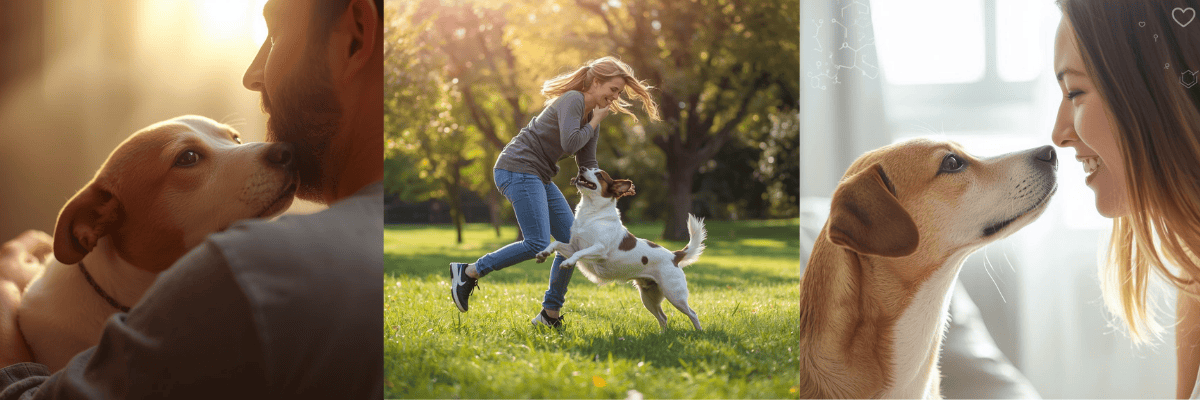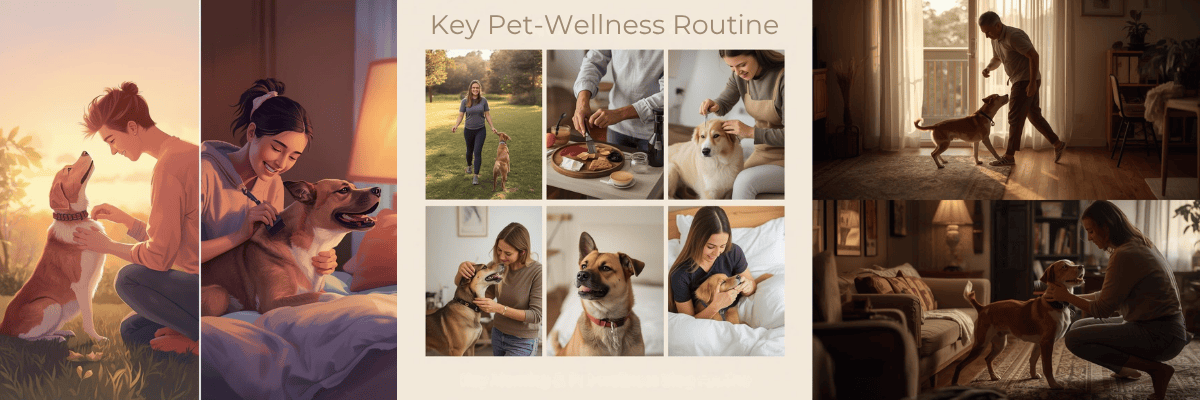Introduction
Dogs communicate their emotions primarily through body language, vocalizations, and behavior. Recognizing whether your dog is happy or anxious is essential for ensuring their well-being, preventing stress-related behaviors, and strengthening the bond between you and your furry companion.
While a wagging tail or playful demeanor may indicate joy, subtle signs like lip licking, tense posture, or avoidance behaviors can signal anxiety. Understanding these cues allows you to respond appropriately—whether it’s encouraging play and interaction or providing reassurance and a safe environment.
In this post, we’ll explore the physical and behavioral signs that distinguish a happy dog from an anxious one, as well as subtle cues, situational context, and strategies to promote happiness while reducing anxiety.
Understanding Dog Emotions
Dogs experience a wide range of emotions, including joy, excitement, fear, and anxiety. Unlike humans, they rely heavily on body language, vocalizations, and subtle behaviors to communicate how they feel.

Why It Matters
- Recognizing your dog’s emotional state helps prevent stress-related behaviors such as aggression, withdrawal, or destructive habits.
- Understanding emotions allows you to respond appropriately, reinforcing positive feelings and addressing anxiety before it escalates.
Happiness vs. Anxiety
- Happiness in dogs is often expressed through relaxed movements, playfulness, and engagement with their environment.
- Anxiety may manifest as tension, avoidance, repetitive behaviors, or signs of fear.
By paying close attention to both physical and behavioral cues, you can accurately distinguish between these emotional states and provide your dog with the support they need.
Physical Signs of a Happy Dog
A happy dog communicates their joy through relaxed, confident body language. Recognizing these physical signs helps you identify when your dog is content and comfortable.

Relaxed Body Posture
- Loose, flowing movements without stiffness.
- No tension in the shoulders, back, or tail.
Wagging Tail
- Tail wags naturally and loosely; speed and direction often indicate positive emotions.
- Broad sweeps are usually friendly and welcoming.
Facial Expressions
- Soft eyes, open mouth, relaxed jaw.
- Ears in a neutral or forward position, showing attentiveness and comfort.
Healthy Appetite and Energy
- Engages in play and exploration.
- Shows interest in food, treats, and activities without signs of stress or hesitation.
By observing these cues, you can confirm that your dog is happy and comfortable in their environment, strengthening your bond and reinforcing positive behavior.
Behavioral Signs of a Happy Dog
Happy dogs often display behaviors that show confidence, engagement, and comfort in their surroundings.
Playfulness and Initiating Interaction
- Engages in games, fetch, or gentle wrestling.
- Approaches people or other pets for attention and fun.
Calm Greetings
- Greets humans and other dogs without fear or tension.
- May wag tail, sniff, or nuzzle in a relaxed manner.
Confident Exploration
- Moves around their environment with curiosity and interest.
- Investigates new toys or areas without hesitation.
Appropriate Attention-Seeking
- Seeks interaction without becoming overly demanding or stressed.
- Enjoys petting, cuddling, or being near family members comfortably.
Recognizing these behaviors allows owners to encourage positive experiences and reinforce a dog’s happiness.
Physical Signs of an Anxious Dog
When dogs feel anxious, their body language often shifts into more tense and guarded postures. These physical signs are key indicators that your dog may be stressed or uncomfortable.
Tense Body Posture
- Stiff movements and rigid muscles.
- Tail tucked between the legs or held low.
Facial Expressions
- Ears pinned back or constantly shifting position.
- Wide eyes showing the whites (known as “whale eye”).
- Excessive lip licking, yawning, or drooling unrelated to food.
Changes in Breathing
- Rapid panting, even without physical exertion.
- Shallow breathing or holding breath during stressful events.
Physical Discomfort
- Shaking, trembling, or pacing.
- Loss of appetite in situations that normally wouldn’t cause it.
By noticing these signals early, you can intervene to comfort your dog and remove them from stressful situations before anxiety escalates.
Behavioral Signs of an Anxious Dog
Anxiety in dogs often shows up through behaviors that signal fear, stress, or unease. These actions may be subtle at first but can escalate if the underlying cause isn’t addressed.
Avoidance Behaviors
- Hiding behind furniture or retreating to a corner.
- Avoiding eye contact or turning away from people or other dogs.
Restlessness and Pacing
- Constant movement, inability to settle down.
- Circling or frequent changes in position when anxious.
Destructive Behaviors
- Chewing furniture, shoes, or other household items.
- Digging or scratching at doors, especially when left alone.
Excessive Vocalization
- Whining, barking, or howling without clear reason.
- Vocalization often increases during stressful events, like separation or loud noises.
Over-Attachment or Clinginess
- Following the owner everywhere, unable to be left alone.
- Seeking constant reassurance, sometimes paired with nervous body language.
Recognizing these behaviors helps you identify when your dog’s anxiety is more than just temporary stress and may require behavioral training, environment changes, or professional support.
Situational Triggers: Context Matters
A dog’s emotional state doesn’t exist in isolation—it’s often influenced by specific situations or environments. Understanding context helps you distinguish between normal behavior and signs of stress or happiness.
Common Triggers for Happiness
- Greeting their owner after time apart.
- Playtime with toys, other dogs, or family members.
- Walks, car rides, and exploring new environments in a positive way.
Common Triggers for Anxiety
- Loud noises such as fireworks, thunderstorms, or vacuum cleaners.
- Separation from owners, leading to separation anxiety.
- Encounters with unfamiliar people, animals, or environments.
- Changes in routine, like moving houses or new family members.
By linking behaviors to context, you gain deeper insight into why your dog reacts the way they do, allowing you to nurture positive experiences while reducing sources of stress.
How to Respond: Encouraging Happiness, Reducing Anxiety
Once you can recognize the signs of happiness and anxiety in your dog, the next step is to respond in ways that reinforce positive emotions and ease stress.

Encouraging Happiness
- Positive Reinforcement: Reward relaxed, joyful behaviors with praise, treats, or play.
- Engagement: Provide regular walks, games, and interactive toys to keep your dog physically and mentally stimulated.
- Bonding Time: Spend quality time with your dog through training, cuddling, or shared activities to strengthen trust.
Reducing Anxiety
- Create Safe Spaces: Offer a quiet area or crate where your dog feels secure during stressful events.
- Calm Reassurance: Speak softly and avoid punishment when your dog is anxious—it may worsen the fear.
- Gradual Exposure: Slowly introduce your dog to triggers (like new environments or sounds) to build resilience.
- Professional Help: For persistent anxiety, consult a veterinarian or certified dog behaviorist for support.
By encouraging positive states and addressing stress thoughtfully, you can help your dog feel happier, calmer, and more confident in their daily life.
Conclusion
Dogs communicate their emotions in ways that are often subtle but deeply meaningful. A relaxed body, playful energy, and curious behavior are signs of a happy pup, while tense posture, avoidance, or destructive habits may reveal underlying anxiety.
By learning to read these signals—and paying attention to the context in which they appear—you can better understand your dog’s emotional world. Responding with reassurance, enrichment, and positive reinforcement not only reduces anxiety but also strengthens the bond you share.
Ultimately, recognizing the difference between happiness and anxiety allows you to create a life for your dog that is full of joy, comfort, and security.




Leave a Reply